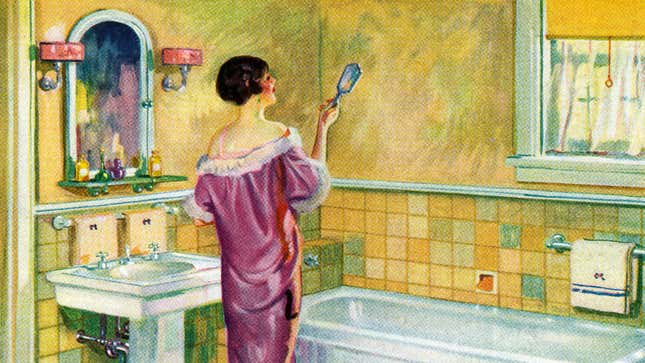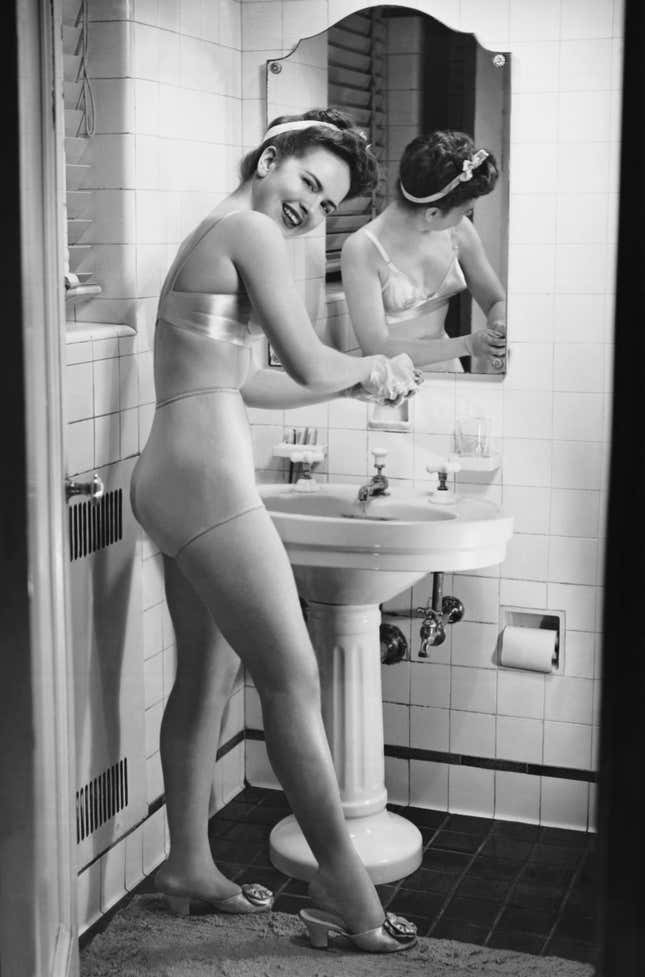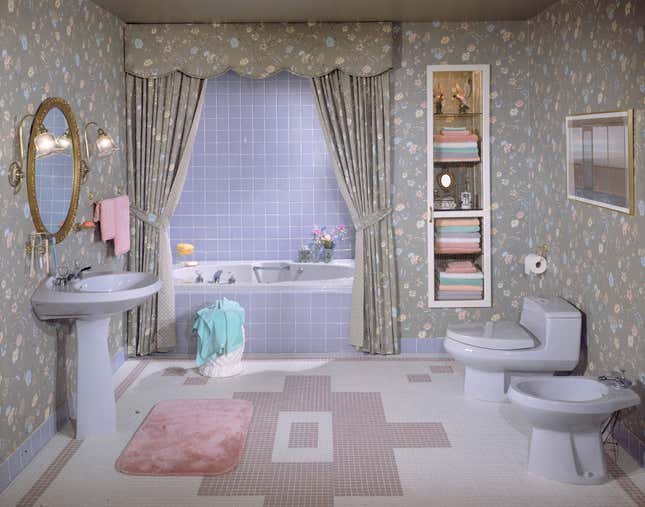
Image: (Photo by GraphicaArtis/Getty Images)
In the pilot episode of CW’s Crazy Ex Girlfriend, Rebecca Bunch, the title character played by Rachel Bloom, is about to go on a date. As she starts prepping in her nondescript bathroom, she begins belting the pseudo-R&B “Sexy Getting Ready Song.” “I’m primpin’ and pluckin’ I’m brushin’ and rubbin’,” she sings, as her bathroom morphs into something like a Hollywood dressing room, replete with candles, vanity mirrors, chandeliers, and a claw-foot tub. She improvises a skincare routine, tries a self-administered bikini wax that ends in blood, and caps it all off with an attempt to shimmy into a girdle.
As cheerfully grotesque and over-the-top as this sequence might be, it deftly embodies the ritualistic aspects that we associate with the bathroom, a space where privacy, voyeurism, and aspiration go hand in hand, and where the most prominent performance of femininity has always been on display.
Bathtime and beauty routines of empresses, queens, princesses, and glamorous women are the subject of endless fascination and far too many listicles. You may well know the highlights: Cleopatra is said to have been fond of rose and patchouli oils; Roman Empress Poppaea used to bathe in donkey milk. The proto lifestyle influencer Marie Antoinette is said to have favored “Eau Cosmetique de Pigeon” a cleanser made of the juice of water lilies, melons, cucumbers, and lemons, as well as the crumbs of French rolls, white wine, and stewed pigeons—all to be distilled. Jayne Mansfield had a floor-to-ceiling pink-carpeted bathroom featuring a gilded, heart-shaped bathtub, basically a Polly-Pocket on steroids. In line with the age of social media, in the last few years, features such as Into The Gloss’s “Top Shelf” and the appearance of bathtime routines of well-heeled women in places like The Cut or Goop have prompted New Yorker writer Rachel Syme to observe what she called “bathfluence” and “bathfluencers.”
The first records of the use of baths date back to 3000 BCE, when water was seen as a ritual and purifying element across the ancient world, including ancient Hindu civilization, Mesopotamia, Egypt, the Israelites, the Hittites, and Greece. All these cultures had semantic areas that signified pollution, and the state of being soiled vs purity, brilliance, and radiance. Liminal states (childbirth), sex, bloodshed, and violation of taboos were seen as pollutants. The most common means of purification is water, whether by washing, sprinkling, or immersing.
In the 10th book of the Iliad, the Achaean heroes Diomedes and Odysseus return from a night expedition and, after washing their sweat off in the sea, they jump into a bathtub and anoint themselves with oil. In the 22nd book of the Iliad, Andromache asks her maidens to draw a bath for Hector, which will reinvigorate him after his battle with Achilles. Unfortunately, her request to her maidens happens right when Achilles starts dragging his corpse across the field to deface it. In Rome, the bathhouses, the thermae (hot) and balinea (the generic term for bathhouse, originally just indicating a bathtub), were seen as a space for relaxation and rejuvenation and existed both in the public and in the private sphere.
Just consider the baths of Caracalla, which were operative and open to the public from the 3rd century to the 6th century CE. Originally measuring 25 hectares (62 acres), they combined bathhouses with other leisurely activities. They contained a cold room (frigidarium, with four pools), a medium- temperature room (tepidarium, with two pools), a hot room (calidarium, with seven pools), and a sweating room (laconica). The natatio, the open-air swimming pool, measured 50 by 22 meters and had bronze panels on the ceiling portion in order to provide sunlight. There were also two boxing gyms, a subterranean Mithraeum (where Mithra was worshipped).
Fewer testimonies of private baths survive, but in the Pompeiian suburb Oplontis there’s the so-called “Poppaea’s villa,” which had its own private thermae. To this day, we can see the remains of the frescoed calidarium, which is adorned with scenes depicting Hercules in the garden of the Hesperides, and a tepidarium. In Pompeii, the Suburban baths were publicly owned but used by a private clientele, and they’re notable for their explicit and realistic erotic-art fresco, depicting various sex positions and group settings.
While researching this piece, I was surprised to learn that in the Middle Ages, people bathed much more than they are given credit for and it was in the Renaissance, post 14th-century plague, that is, that water started being regarded as a vector for diseases among the general population. Its usage only survived in the upper echelons of society. “Only a noblewoman would have the privilege of taking a bath. The water would almost certainly have been cold and there are no signs of soap or anything with which to scrub the body. Cleaning at the time was believed to have been done as much with salves and herbs and flowers that scented the body as with water,” reported the New York Times in a feature on the 2015 French-based exhibition “La Toilette: The Birth of Privacy,” the first major art exhibition to examine the way bathrooms were depicted in art history. “With the exception of the occasional pitcher used for rinsing hands or washing feet, it seems most people didn’t wash much.”
At this point, we mainly see goddesses in the act of bathing—Venus emerging from the seafoam or looking at herself in the mirror and Artemis bathing with her nymphs as a hapless hunter happens upon the scene. But that begins to shift in the Renaissance.
The earliest known example of an ordinary woman—not a goddess or a biblical figure—in the nude dates back to the early 1500s. In it, an aristocratic woman naked except for a see-through cloth covering her lower body and what we’d call statement jewelry. She is immersed in a tub and is surrounded by musicians and handmaidens as she is bathing. There’s no trace of embarrassment in the bather, despite the fact that some of her attendants are men. We know she is an aristocratic woman and not a goddess because the tapestry is part of a cycle titled Vie Seigneuriale, a series of six tapestries depicting the daily activities of courtly life, which, aside from the bathing ritual, include women doing embroidery work, characters promenading, courtship rituals, and the reception of other aristocrats.

Towards the end of the 16th century, the late-mannerist Fontainebleu school of painting presented women in the act of bathing. One is holding a ring, and is getting her nipple pinched by the other woman. Gabrielle d’Estrées and One of Her Sisters depicts two women sitting in a bathtub. One can interpret this work as having sapphic undertones, but the act of pinching the woman’s breast might also hint at the latter’s pregnancy, possibly of an illegitimate child. Another Fontainebleu painting has a woman in the nude gazing at herself in a handheld mirror. The mirror is closely associated with the goddess Venus: Titian famously painted Venus in Furs, where a fur-clad golden-haired goddess looks at herself in a mirror as two Cupids help her in her beauty ritual, one holding said mirror upright, the other offering her a flower wreath. In the case of the Fontainebleu painting, the nude woman has an idealized body and markers of wealth and aristocracy that can make us identify her with Venus too.
“The rite here represented is not just hygienic,” reads the catalogue of La Toilette (translated from French). “The act of toiletry is a ritual dance: the body moves without displacing itself, in gestures that remain identical day by day: this dance can only be seen by the one performing it. The artist representing it pretends they’re not even there.”
The 17th and 18th centuries brought a dose of naturalism. Women at their toilets were a popular subject for 17th-century Dutch painters. Gerard ter Borch, for example, produced a delicate canvas in 1650 showing a young woman in a richly decorated interior standing in front of her mirror. Like most genre paintings from the period, it’s likely that ter Borch’s canvas carries multiple meanings perhaps, even, a meditation on the fleetingness of youth (the girl is juxtaposed here with an elderly maid, enhancing her youth and beauty).
Similarly, Nicholas Reigner had an aristocratic woman adorn herself with flowers in the mirror—too bad that nestled behind said mirror rests an anti-poetic chamber pot. In 18th-century France, with the onset of boudoir, these portrayals of women à la toilette become even more farcical. François Boucher, mainly known for his mythological subjects, combined the standard rococo color palette (think sherbet or pastel-hued gowns), with a salacious depiction of private activities: in La Jupe Relevee (1742-1760) he depicts a woman urinating in a pot while lifting her heavy skirt. In L’Oeil Indiscret (1742-1769), a pink-clad woman flashes her bare buttocks to the viewer. But for all of Boucher’s rococo cheekiness, what endures is his elegant depiction of aristocratic women at their toilettes. His (attributed) portrait of Madame du Pompadour, the official mistress of Louis XV, shows her in all of her renowned elegance: artfully applying rouge before a mirror, with a reflection only she sees.
As all fads do, the interest for the aristocratic, goddess-like female bather wanes in the first half of the 19th century, when the voyeuristic habits of pseudo-communal bathing started being frowned upon by etiquette manuals. “We have to admit that there used to be things that were really in bad taste,” wrote Madame de Genlis in her Dictionnaire des étiquettes, dated 1818, “such as the habit among women of getting dressed in front of men and the habit of getting painted while doing their toiletries.”
Plumbing changes the concept of the bath entirely. “The Plumber… is the pioneer of cleanliness. He is the first artisan of the state, the billeting officer of culture, of today’s prevailing culture. Every English washbowl with its faucet and casting is a sign of English progress,” wrote Austrian architect and modernism theorist Adolf Loos in his 1898 essay “Plumbers.” That’s also when our current concept of privacy emerged: “Privacy should be seen as a modern invention that decisively broke with attitudes towards the body that had prevailed for much of human history,” writes Barbara Penner in her book Bathroom, which chronicles the architectural and cultural evolution of the room and space we’ve now come to refer to as the bathroom. The act of getting ready, often done in the bathroom, is no longer public as it was for Madame du Pompadour; by the end of the 19th century, those acts are made private and intimate.
So, in the second half of the 19th century, artists shift to the demi-monde, and stop classicizing the female body. In Edouard Manet’s Nude Woman Doing Her Hair, the woman is heavyset; by contrast, in Alexandre Theophile Steinlen Le Bain, the subject looks almost scrawny; the woman in František Kupka’s Lipstick wears a grotesque face of makeup. The gestures of these women are no longer codified, but they almost become prosaic and perfunctory.
It is in 20th-century literature that bathrooms and the act of bathing acquire psychological connotations and have their performative aspect laid bare. That is particularly true for women. Make-up, once the prerogative of “painted ladies” in the 19th century, as hiding one’s own filth with powder was no longer a pressing concern with water more readily available, acquired mainstream acceptability after World War I thanks to women entrepreneurs like Estée Lauder, Elisabeth Arden, and Helena Rubinstein. “Marketers heightened women’s image consciousness by reminding them of other people’s critical scrutiny. For example, one ad warns women, “Strangers’ eyes, keen and critical – can you meet them proudly, confidently, without fear?”
“Positioned as objects of an outsider’s gaze, female viewers of commercial culture were, for the first time, invited to see themselves as recipients of evaluative looks,” Carla Rice argues. Art reflects this view. Woman in the Mirror, by the Italian magical-realist painter Cagnaccio di San Pietro (1930) depicts a half-naked woman at her Toilette intent on applying her make-up. Her haircut indicates she’s fashion-conscious, her body respects the beauty standards of that era: she appears to be well taken care of, and her color-coordinated coral-toned make-up kit, in contrast with the cobalt-blue bathroom walls, looks aspirational and bourgeois rather than a relic from the demi-monde.

Just as Lady Macbeth frantically tries to scrub her hands clean in her delirium, so does Tennessee Williams’s Blanche in A Streetcar Named Desire (1947): throughout the play, she draws frequent baths to quiet her nerves. “A hot bath and a long, cold drink always give me a brand new outlook on life!” she proclaims, even though this is only a temporary respite, and it’s all futile escapism. Blanche’s attitude towards the mirror exemplifies this. “Tremblingly, she lifts the hand mirror for a closer inspection. She catches her breath and slams the mirror face down with such violence that the glass cracks,” read the stage-direction notes for Scene 10, when she appears decked in a somewhat soiled and crumpled white satin evening gown, a pair of scuffed silver slippers with brilliants set in their heels and a rhinestone tiara.
In the Bell Jar, taking a bath has a cathartic effect on the protagonist Esther. “Whenever I am sad I’m going to die, or so nervous I can’t sleep, or in love with somebody I won’t see for a week, I slump down just so far and then I say ‘I’ll go take a hot bath,” she explains in chapter 3. To her, the bath is a symbol of holiness and purity, a way to cleanse from the dirt of daily life. “I guess I feel about a hot bath the same way those religious people feel about holy water,” she explains, even though we, as readers, will witness the deterioration of her mental health. When, later in the novel, she entertains the idea of suicide, she changes her mind as there is no bathtub in which to attempt it. Also, to Esther, the mirror is a way to dissociate from reality.
In a way, we see a similar performative and vain nature of bathroom rituals in The Marvelous Mrs. Maisel, when Midge falls asleep next to her husband with a full face of makeup, only to then flee to the bathroom once he is fast asleep. There, she removes her make-up, puts on curlers, and a heavy face cream. She repeats this routine in reverse in the morning, waking up at the crack of dawn to put on her “day face” and do her hair before her husband is awake. It’s a scene that mirrors the conformism of their marriage, and it’s only after one of their post-breakup impromptu trysts that her husband will see what she really looks like without the glamour of her “day face” in the morning.
To this day, this ambivalence between the facetious and the healing aspect of the bathroom and its rituals still remains. Where Jia Tolentino once declared that a meticulous skincare routine is a necessary self-care ritual in a historical moment marred by uncertainty, and Rachel Syme encourages us to share our individual hacks for our “tub game,” we also have dubious recommendations by influencers like Summer Dawn, who in a first expunged, and now-deleted interview with Violet Grey claimed that she added a hefty dose of hydrogen peroxide to her daily soak. Then there’s Goop pushing their $35 “Recovery Bath Soak,” a turmeric-based formula that is guaranteed to stain your porcelain bathtub with a golden hue that will take a lot of elbow grease to clean. The Ritual Baths of Mama Medicine look gorgeous too: they’re basically three-dimensional versions of Monet’s waterlilies or Botticelli flower beds. But how belaboring will the clean-up process be? It should not matter, as bathroom scenes represent a specific moment and ritual in time, with little thought about the before/after.
Still, the bathroom remains a place of transformation, where water and mirrors can help us become whatever version of our current self we see most apt for that time and place.
Angelica Frey is a writer and a translator. No form of visual arts is beneath her curiosity, and her work has appeared in places including The Cut, The Guardian, Artsy, Hyperallergic, Garage, Art and Object, and AirMail; read her work at www.angelicafrey.com.